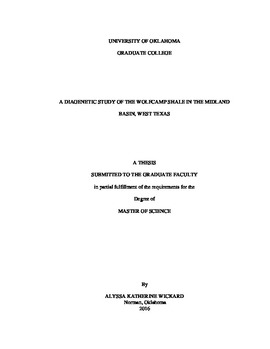| dc.description.abstract | The lower Permian Wolfcamp Shale is a major unconventional resource play in the Permian Basin. Near the eastern margin of the Midland Basin the Wolfcamp Shale is comprised of calcareous and siliceous mudstones interbedded with carbonate turbidites and debris flows which contain calciclastic lithoclasts. Petrographic methodologies were used to study two cores from near the eastern shelf of the Midland Basin to compile a diagenetic history. The paragenesis is complex with lithoclasts diagenesis that occurred on the platform and whole rock diagenesis which occurred in the basin. Some lithoclasts contain an apparent marine calcite cement followed by blocky calcite cement. Partial chert replacement in the lithoclasts is evident, however the timing is unknown. Other phases include authigenic replacement of allochems in the lithoclasts by albite, dolomite, ferroan dolomite and pyrite.
In the calcareous and siliceous mudstones in the basin, early diagenetic phases include framboidal pyrite, phosphatic concretions, calcareous concretions, quartz, and dolomite with ferroan rims. Authigenic sphalerite occurs as thin beds and is also found displacing barite in laminae in the mudstone matrix, the timing of which is interpreted as early diagenesis and is likely related to bacterial sulfate reduction. Another generation of barite is also interpreted as being remobilized during early to middle burial diagenesis. Clay diagenesis occurred during middle to late diagenesis and includes illitization, iron-rich chlorite, and kaolinite converting to dickite. Within carbonate intervals early cementation of calcite and ferroan calcite are followed by dolomite and ferroan dolomite cements during middle diagenesis. Dissolution of allochems occurred during middle diagenesis dolomite. Dolomite is also found partially overprinted by chert. Organic matter is present, filling porosity in pyrite framboids and between clay sheets.
Horizontal fractures, likely a result of overpressuring, are filled by ‘beef’ type calcite. Vertical fracture networks display an array of textures, either cleanly cutting siliceous mudstones and terminating against the carbonate intervals, or complex anastomosing patterns in the carbonate gravity flows and calcareous mudstones. Vertical fractures are commonly filled by equant calcite with ferroan alteration along the edges. Also present are mineralized fractures composed of celestine and barite, which demonstrate evolving fluids as the fracture fill changed from Sr-rich on the edges to Ba-rich in the middle. Fluid inclusions in barite fractures have relatively high salinities (25 Wt%) and an average entrapment temperature of 105 ˚C. The final stage of mineralization in all vertical fracture fill types is ferroan dolomite, which is found as individual rhombs filling fracture porosity.
Investigating the diagenetic stages in the Wolfcamp Shale helps constrain which mineral phases can hamper or improve reservoir quality by impacting fracability, porosity distribution, and potential fluid pathways. Carbonate cementation and chertification occluded primary porosity in the Wolfcamp Shale, but improved fracability of turbidite intervals. Porosity is found in pyrite framboids, as nano-pores in organic matter, and between clay sheets, in dolomitized intervals, as molds in carbonates, and in fractures. Most of the authigenic minerals found in the Wolfcamp Shale can be explained by internal mechanisms, such as, bacterial sulfate reduction, shale dewatering, and clay diagenesis, where mineral events were sourced internally during burial diagenesis. However, fracture networks cross multiple facies and appear to have acted as fluid conduits for high salinity fluids, suggesting that the Wolfcamp Shale was open to external fluids during middle to late diagenesis. | en_US |
